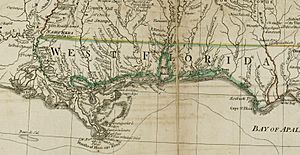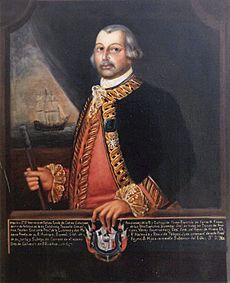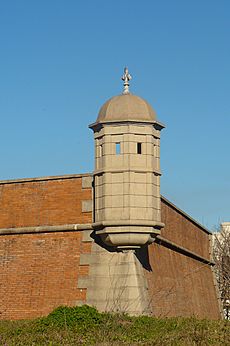Battle of Fort Charlotte facts for kids
Quick facts for kids Battle of Fort Charlotte |
|||||||
|---|---|---|---|---|---|---|---|
| Part of the Western Theater of the American Revolutionary War |
|||||||
 Detail from a 1776 map showing West Florida |
|||||||
|
|||||||
| Belligerents | |||||||
| Commanders and leaders | |||||||
| Bernardo de Gálvez | Elias Durnford (POW) | ||||||
| Strength | |||||||
| 7,500 regulars and militia (most from Cuban expedition) | 3,500 regulars and militia | ||||||
| Casualties and losses | |||||||
| 272 | 1,320 | ||||||
The Battle of Fort Charlotte, also known as the Siege of Fort Charlotte, was an important fight during the American Revolutionary War. It happened in 1780 in a place called Mobile. At that time, Mobile was part of British West Florida.
This battle was a two-week siege led by Spanish General Bernardo de Gálvez. He attacked the British fort that protected the port of Mobile. Fort Charlotte was the last British outpost that could threaten New Orleans, a Spanish city. When the fort fell, the British lost control of the western part of West Florida. Their main presence in the area was then only in Pensacola.
General Gálvez's army sailed from New Orleans on January 28, 1780. They landed near Fort Charlotte on February 25. The British soldiers inside the fort were outnumbered. But they fought bravely. The Spanish kept firing their cannons until the fort's walls broke. The British commander, Captain Elias Durnford, hoped for help from Pensacola. But no help came. He had to surrender. This victory gave Spain control of Mobile Bay. It also cleared the way for Spain to attack Pensacola later.
Contents
Why the Battle Happened
When Spain joined the American Revolutionary War in 1779, Bernardo de Gálvez was the governor of Spanish Louisiana. He was a very active leader. He quickly started attacking British areas. In September 1779, he took control of the lower Mississippi River. He did this by capturing Fort Bute. Then, he made the remaining British forces on the river surrender after the Battle of Baton Rouge.
After these wins, Gálvez planned to attack Mobile and Pensacola. These were the last British strongholds in West Florida.
Spanish Army Prepares
Gálvez gathered a mixed army in New Orleans. It included both regular Spanish soldiers and local militia. He had asked for more troops from Havana in 1779, but his requests were turned down. Before leaving New Orleans, he sent one of his officers to Havana to ask one more time.
On January 11, 1780, a fleet of twelve ships carrying 754 men set sail. They reached the mouth of the Mississippi River on January 18. On January 20, they were joined by the ship Gálveztown. This ship was commanded by Captain William Pickles and had a crew of 58.
On February 6, a storm scattered the fleet. But all the ships managed to arrive outside Mobile Bay by February 9. Getting into the bay was hard. Several ships got stuck on sandbars. One ship, the Volante, was even wrecked. Gálvez saved cannons from the wrecked ship. He set them up on Mobile Point to guard the bay entrance.
On February 20, more soldiers arrived from Havana. This brought the Spanish force to about 1,200 men. By February 25, the Spanish army had landed on the shores of the Dog River. This was about 10 miles (16 km) from Fort Charlotte. A British soldier who had left the fort told them that about 300 men were defending it.
British Defenses at Fort Charlotte

Fort Charlotte was first built by the French in 1717. It was called Fort Condé back then. Mobile was part of French Louisiana at that time. In 1763, after the French and Indian War, the British took over. The fort was in bad shape. It was repaired then, but by 1779, it needed repairs again.
The soldiers defending the fort were mostly from the 60th British regiment. They were joined by Loyalists from Maryland and Pennsylvania. Local volunteers also helped. In total, there were about 300 defenders. Captain Elias Durnford was in charge of the fort. As soon as he heard about Gálvez's victories, Durnford started improving the fort's defenses.
The Siege Begins
On March 1, Gálvez sent an officer to Captain Durnford. He offered Durnford a chance to surrender. Durnford politely refused. The next day, Gálvez started setting up his cannons around the fort. Durnford wrote to General John Campbell in Pensacola. He asked for more soldiers to help. On March 5 and 6, most of the Pensacola soldiers started marching towards Mobile. But they were slowed down by difficult river crossings. This meant they could not help the Fort Charlotte defenders.
While the Spanish moved their cannons closer to the fort, Gálvez and Durnford exchanged polite letters. For example, Gálvez gently criticized Durnford for burning some houses. Durnford had burned them to stop the Spanish from using them for cover. Durnford replied by saying that the other side of the fort would be a better place for an attack. All this time, the Spanish kept digging trenches and firing cannons at the fort.
On March 13, the walls of Fort Charlotte were broken. Durnford surrendered his soldiers the next day.
What Happened Next
After winning at Fort Charlotte, Gálvez did not immediately attack Pensacola. He wanted to take advantage of the British being disorganized. But he knew Pensacola was strongly defended with powerful cannons. So, he asked Havana for a lot of naval support again. In April, he learned that more British ships and soldiers had arrived at Pensacola.
Without enough reinforcements, Gálvez left some soldiers in Mobile. He then went to Havana to gather the troops and equipment needed for a bigger attack on Pensacola.
Gálvez finally launched his successful attack on Pensacola in 1781. This happened after the soldiers in Mobile fought off a British counterattack in January 1781.
Fort Charlotte was torn down in the 1800s. In the late 1900s, its old foundations were found again. A smaller copy of the fort was built on its site. The fort is now listed on the National Register of Historic Places.
See also
 In Spanish: Batalla del Fuerte Charlotte para niños
In Spanish: Batalla del Fuerte Charlotte para niños
- American Revolutionary War § Mississippi River theater. This link helps you see where the Battle of Fort Charlotte fits in the bigger picture of the war.


